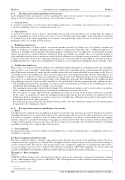Page 564 - SAIT Compendium 2016 Volume2
P. 564
IN 64 (3) Income Tax acT: InTeRPReTaTIon noTes IN 64 (3)
4.3.1 Receipts and accruals qualifying as levy income
In determining whether an amount is a levy, regard must be had to the true nature of the transaction. For example, a charge for the late payment of a levy is likely to be in the nature of interest.
(a) General levies
A ‘general’ levy usually covers the day-to-day running, maintenance or operating costs. General levies received by or accrued to qualifying entities are exempt from income tax.
(b) Special levies
A ‘special’ levy may be raised to pay for capital improvements such as the installation of a satellite dish, the laying of paving or upgrading of security fencing or to create a reserve for future capital expenditure such as the future resurfacing of a tennis court or the future upgrading of an entrance and guard house. Special levies received by or accrued to qualifying entities are exempt from income tax.
(c) Building penalty levies
The management rules of a home owners’ association sometimes provide for a higher levy to be paid by a member for failing to commence or complete building activities within a certain period. Typically such a ‘building penalty levy’ is expressed as a multiple of the normal levy, the primary purpose of which is to recover additional costs incurred by the home owners’ association as a result of delayed construction. Such costs include, for example, the cost of repairing damage to roads and kerbs caused by heavy construction vehicles and the additional cost of hiring security personnel to ensure that the security of other home owners is not compromised by the presence of vacant stands or by the in ux of construction workers. A building penalty levy of this nature will qualify for exemption as a levy and must be distinguished from a penalty or ne.
(d) Stabilisation fund levies
Home owners’ associations sometimes establish a levy stabilisation fund for the purposes of subsidising day-to-day expenditure and to provide a reserve for future capital improvements or unforeseen expenditure on the common immovable property. A fund of this nature is intended to ensure that the monthly and special levies remain affordable by smoothing out the levies to avoid undue increases in monthly levies. The levy may be imposed as a once-off payment either when the owner disposes of a unit (a departure or exit levy) or when a person purchases a unit (an entry levy). The payments may be xed or determined as a percentage of a certain amount such as a percentage of the selling price of the unit. The contribution to the stabilisation fund of a qualifying association of persons will be regarded as a levy provided the following requirements and conditions are met:
• The founding document of the qualifying association of persons must make provision for the establishment of a levy
stabilisation fund including rules relating to its governance;
• The founding document must stipulate that the funds of the stabilisation fund may only be used to defray expenditure
on the common immovable property governed by the qualifying association of persons.
• The levy must be a charge imposed by the qualifying association of persons on the member. If the levy is payable by the owner on alienation of a unit, the founding document must specify that the amount to be paid into the levy stabilisation fund on joining the association of persons is a liability due, although only payable by the member when
the member alienates the unit or property.
• The methodology under which the amount that will be payable to the levy stabilisation fund is to be determined, must
be speci ed in the founding document.
4.3.2 Receipts and accruals not qualifying as levy income
(a) Fines
A member may be required to pay an additional amount over and above any general or special levy which is not related to expenditure incurred or to be incurred in relation to the common immovable property. Receipts of this nature often occur as a result of a member’s conduct or lack of conduct and are instituted to encourage a desired behaviour, for example, amounts charged as a penalty for littering or engaging in activities that disturb other residents. In these instances the receipts will not qualify as levy income since they do not represent an amount collected with the intention of funding expenditure relating to the common immovable property.
(b) Late payments
Late payment penalties or interest charged on outstanding levies or other amounts payable to a qualifying entity do not constitute levy income.
4.4 Basic exemption and effective date
The basic exemption* applies to all the receipts and accruals other than levy income of the qualifying entities. The basic exemption came into operation on 1 January 2009 and applies from the commencement of years of assessment ending on or after 1 January 2009. This effective date means that the basic exemption is applicable to all qualifying entities whose year of assessment ends on or after 1 January 2009. The basic exemption of R50 000 is applied to the total receipts and accruals, excluding the levy income, which are taxable and not to each separate source of income.
Example 2 – Basic exemption
Facts:
ABC Estate Home Owners’ Association has been formed to manage the maintenance and general expenditure relating to the common immovable property of ABC Estate. The following income is re ected in the nancial statements for the year ended 30 June 2015:
* Section 10(1)(e)(ii).
556 saIT comPendIum oF Tax LegIsLaTIon VoLume 2


